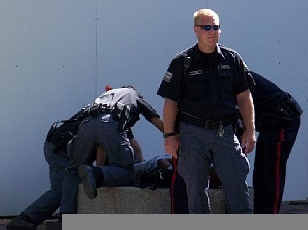 Last month the Eleventh Circuit Court of Appeals denied two Florida police officers motion for summary judgment on qualified immunity grounds. Sanchez v. Hialeah Police Dep’t, 2009 U.S. App. LEXIS 27607 (11th Cir. Fla. Dec. 16, 2009)
Last month the Eleventh Circuit Court of Appeals denied two Florida police officers motion for summary judgment on qualified immunity grounds. Sanchez v. Hialeah Police Dep’t, 2009 U.S. App. LEXIS 27607 (11th Cir. Fla. Dec. 16, 2009)
A young man, Erik Sanchez, had sued them in federal court, pursuant to 42 U.S.C. §1983. In his suit he contended that the City of Hialeah Police Officer Del Nodal had violated his Fourth Amendment right to be free from excessive force by repeatedly striking him in the head with a baton and that fellow Officer Garrido failed to intervene. The Court of Appeals affirmed the district court’s denial of qualified immunity for the police.
The position Officer Del Nodal argued was that his reaction was objectively reasonable when he opened the car door, punched Sanchez in the eye, and sprayed him with mace after Sanchez broke the police car window. However, as Erik Sanchez, a minor at the time of the attack explained, Officer Garrido pulled Sanchez from the car, ordered him to the ground filled with broken glass, and repeatedly struck him with a baton after macing him. Sanchez also alleges that Officer Del Nodal of striking him 10 times with his baton — with 5 blows going to his head — resulting in at least two head lacerations requiring 15 metal staples to close, causing heart abnormalities, and life threatening injuries.
The Court of Appeals ruled that a jury, taking the facts in a light most favorable to Sanchez, could reasonably find that Officer Del Nodal violated Sanchez’s right to be free from excessive force and that qualified immunity does not apply.
Under the law of analyzing the applicability of qualified immunity, the Court has at its disposal a two-step process. Traditionally, a court first determines whether the officer’s conduct amounted to a constitutional violation. Second, the court analyzes whether the right violated was clearly established at the time of the violation.
The Court in this particular case analyzed the claim of excessive force under the Fourth Amendment’s ‘objective reasonableness’ standard.” Thus, the question was whether the officer’s conduct is objectively reasonable in light of the facts confronting the officer. Determining whether the force used to effect a particular seizure is ‘reasonable’ under the Fourth Amendment requires a careful balancing of the nature and quality of the intrusion on the individual’s Fourth Amendment interests against the countervailing governmental interests at stake.
The Court explained that the analysis requires careful attention to the facts and circumstances of each particular case, including the severity of the crime at issue, whether the suspect poses an immediate threat to the safety of the officers or others, and whether he is actively resisting arrest or attempting to evade arrest by flight. Additional considerations include: (1) the need for the application of force, (2) the relationship between the need and the amount of force used, (3) the extent of the injury inflicted and, (4) whether the force was applied in good faith or maliciously and sadistically. Hadley v. Gutierrez, 526 F.3d 1324, 1329 (11th Cir. 2008)
Notably, the Court of Appeals explained that they consistently have allowed an excessive force claim to go forward where an arrestee was handcuffed, posed no risk of danger to the officer, and was not resisting arrest. Sanchez v. Hialeah Police Dep’t, 2009 U.S. App. LEXIS 27607 (11th Cir. Fla. Dec. 16, 2009)
Continue reading →
 On Monday, February 21st, seven prison guards from Macon State Prison were arrested on charges of beating Mr. Terrence Dean, a client of Williams Oinonen LLC, so badly that he sustained brain injuries and was partially paralyzed.
On Monday, February 21st, seven prison guards from Macon State Prison were arrested on charges of beating Mr. Terrence Dean, a client of Williams Oinonen LLC, so badly that he sustained brain injuries and was partially paralyzed.  Georgia Injury Lawyer Blog
Georgia Injury Lawyer Blog


 Last month the Eleventh Circuit Court of Appeals denied two Florida police officers motion for summary judgment on qualified immunity grounds. Sanchez v. Hialeah Police Dep’t, 2009 U.S. App. LEXIS 27607 (11th Cir. Fla. Dec. 16, 2009)
Last month the Eleventh Circuit Court of Appeals denied two Florida police officers motion for summary judgment on qualified immunity grounds. Sanchez v. Hialeah Police Dep’t, 2009 U.S. App. LEXIS 27607 (11th Cir. Fla. Dec. 16, 2009)